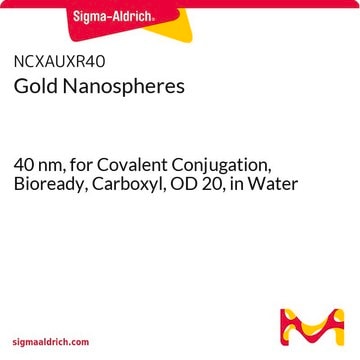765546
Gold nanoparticles
30 nm diameter, carboxylic acid functionalized, PEG 5000, OD 50, dispersion in H2O
Sinônimo(s):
Gold nanoparticles COOH functionalized, Au NP COOH, Gold Colloid
About This Item
Produtos recomendados
Materiais
PEG 5000
Nível de qualidade
Formulário
dispersion in H2O
nanoparticles
embalagem
poly bottle of 1 mL
DO
50
diâmetro
30 nm
pH
6.0-8.0 (25 °C)
solubilidade
water: miscible
densidade
1.00 g/cm3
λmax
525 nm
grupo funcional
carboxylic acid
temperatura de armazenamento
2-8°C
Procurando produtos similares? Visita Guia de comparação de produtos
Descrição geral
Aplicação
- Since they adhere to cell membranes, AuNPs may find use in cellular and intracellular targeting in targeted drug delivery applications and may also be used in biodistribution studies.
- AuNPs may also be used in photothermal therapy and radiotherapy.
- AuNPs ranging from 10 to 250 nm, were studied to have been absorbed primarily by liver and spleen, when injected intravenously in rats.Whereas, 10 nm nanoparticles were distributed more broadly into various organs.
- Carboxylic acid end-groups binds with various proteins and hence are used in targeted drug delivery and gene therapy.[1][2][3][4]
Código de classe de armazenamento
12 - Non Combustible Liquids
Classe de risco de água (WGK)
WGK 1
Ponto de fulgor (°F)
Not applicable
Ponto de fulgor (°C)
Not applicable
Escolha uma das versões mais recentes:
Já possui este produto?
Encontre a documentação dos produtos que você adquiriu recentemente na biblioteca de documentos.
Os clientes também visualizaram
Artigos
The recent emergence of a number of highly functional nanomaterials has enabled new approaches to the understanding, diagnosis, and treatment of cancer.
Biomaterials science integrates smart materials into biological research, requiring a deep understanding of biological systems.
Active Filters
Nossa equipe de cientistas tem experiência em todas as áreas de pesquisa, incluindo Life Sciences, ciência de materiais, síntese química, cromatografia, química analítica e muitas outras.
Entre em contato com a assistência técnica





